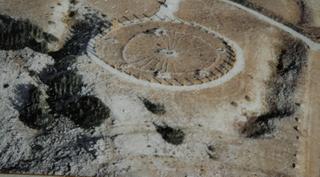Do I work in construction, of course not. But I like models we develope. How we go about building them. While I may have developed them in my own mental and physical life, this entry, is about what the youth of today, can do in their own lives.
I also wanted to speak about the foundation of institutions, as well as, describe what is happening in my life right now. That this indeed is taking up some of my time. It's a worthy effort, working by my son, to uphold the understanding, that "fear of doing" should not limit us in our pursuates. That physical work demands, "strong motivational hearts" to succeed. Careful planning and execution.

Well of course above, there lies the remains physically challenged by time and the destruction of, by the powers that be then.
It was this picture that I was reminded of, as I looked across the work we had been doing to raise the house for my daughter-in-law and son. Yes, today, they pour the footings, and then, we shall progress from here.

As we were setting this up, I couldn't help but think of the attempts of our good scientists, who undertake the challenge to do their "own work" in the real world. To provide for, "construction corrections" to the homes that they live in. What is a home? What is a solid foundation in the sense of being secure?

But I could fast forward here, to this heightened view, just to remind you of this elevation of thought, so I'll place this perspective my son captured, while, what had transpired should be spoken about.
One might quickly forget the calculations in making sure we work on this "2D plain" according to the schematics of the archetectural drawing. It is this basis(model) of the house, with which they have chosen.
So! I sat and thought about it during the previous couple of days. While I watched the spirit of my son work hard, while others worked hard, asking what lead such inexperience to challenge what only existed in the mind of professionals. To take on such a task?
Research, and more research, and a willingness to do what was thought unimaginable?
Can it be said then, that it is this limitation that is forced on self, that any of us, had we not set our minds to it, couldn't have moved in the world the same way? Not to be afraid? To move beyond the world in it's accustom ways, was to encourage the self away from such conceptual stumbling blocks?
Pythagorean's Theorem
The theorem has been known in many cultures, by many names, for many years. Pythagoras, for whom the theorem is named, lived in ancient Greece, 2500 years ago. It is believed that he learned the theorem during his studies in Egypt. The Egyptians probably knew of the relationship for a thousand years before Pythagoras. The Egyptians knew of this relationship for a triangle with sides in the ratio of 3 - 4 - 5".
So it was of course important, that as we laid out the footings, keeping in mind the level from a heighten perspective, that we set out the basis of all our work from which all things would progress.
The Transit LevelWhile the model below is one of many designs, we used another model to help us with our leveling of the footings.
Many times in my youth growing up, it was important that this tool be used, so from it my talks about frame sof referenc ewas gain from actual hands on experience.
I relayed a story to my son, when he was around ten, as he set hs eyes upon work that I had been doing to arrive at a level. Of course, it was "long forgotten," but awoken when refreshed, the idea and foundational perspective is still alive and strong as a basis of the tools we need to do work in "frames of reference."

So of course we are thinking as we developed the "2d dimensions" to allot for a "frame of reference," for how could all things progress? How shall we do this, if we do not move to a third dimensional reference point? How do we arrive at a heightened perspective from all that has been laid out, if we had not raised oneself as my my son had, to include a picture of the whole site?












